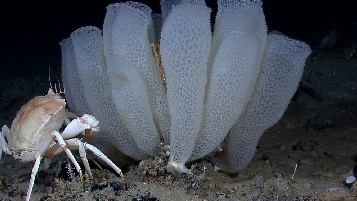120-venus flower basket.jpg

A golden crab with a group of Venus flower basket glass sponges. Credit: National Oceanic and Atmospheric Administration
The white vase-like sea sponge known as the Venus flower basket would seem incredibly fragile since it’s made of silica, the main ingredient of glass. Further, the only thing keeping this glass sponge anchored to the sea floor is a tuft of tiny glass structures called spicules, each about the thickness of a human hair.
Yet these sponges manage to hold firm and resist bending in the current in harsh environments as deep as 1000 meters below the surface, while they filter nutrients from the water. The secret to their strength is in the geometric structure of those thin glass spicules.
Engineers investigated their configuration and found that the narrow glass core of each spicule has between 10 and 50 tiny concentric glass cylinders surrounding it – all within a structure about five one hundredths of a millimeter thick. The organic material between each concentric cylinder becomes narrower and narrower moving outward from the center toward the edge.
So the engineers built a mathematical model of the structure of a spicule to determine the ideal configuration of layers for withstanding the greatest load. The model predicted that the strongest arrangement was one with each successive concentric layer being increasingly thinner – exactly as they found in the actual animal.
But this finding is more than a curiosity. Nature’s designs can inspire human designs, especially when it comes to building strong structures. Knowing how effectively those tiny glass spicules hold up the cylindrical sponge for years may help engineers design stronger load-bearing beams on land.


